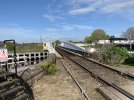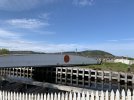EbbwJunction1
Established Member
- Joined
- 25 Mar 2010
- Messages
- 1,565
I was scoring for a cricket match at Barry Athletic CC yesterday, and it was an opportunity to see the Class 150s going into and out of Barry Island station.
I was struck by the slow speed that they travelled over the bridge from the mainland and correspondingly the same when they returned - they were almost at a crawl. I wondered why this was so - is there a significant gradient between the bridge and the station (it looks like there is) or is there another reason? Also, is there a reason why they go so slow on the return journey?
Thanks.
I was struck by the slow speed that they travelled over the bridge from the mainland and correspondingly the same when they returned - they were almost at a crawl. I wondered why this was so - is there a significant gradient between the bridge and the station (it looks like there is) or is there another reason? Also, is there a reason why they go so slow on the return journey?
Thanks.


